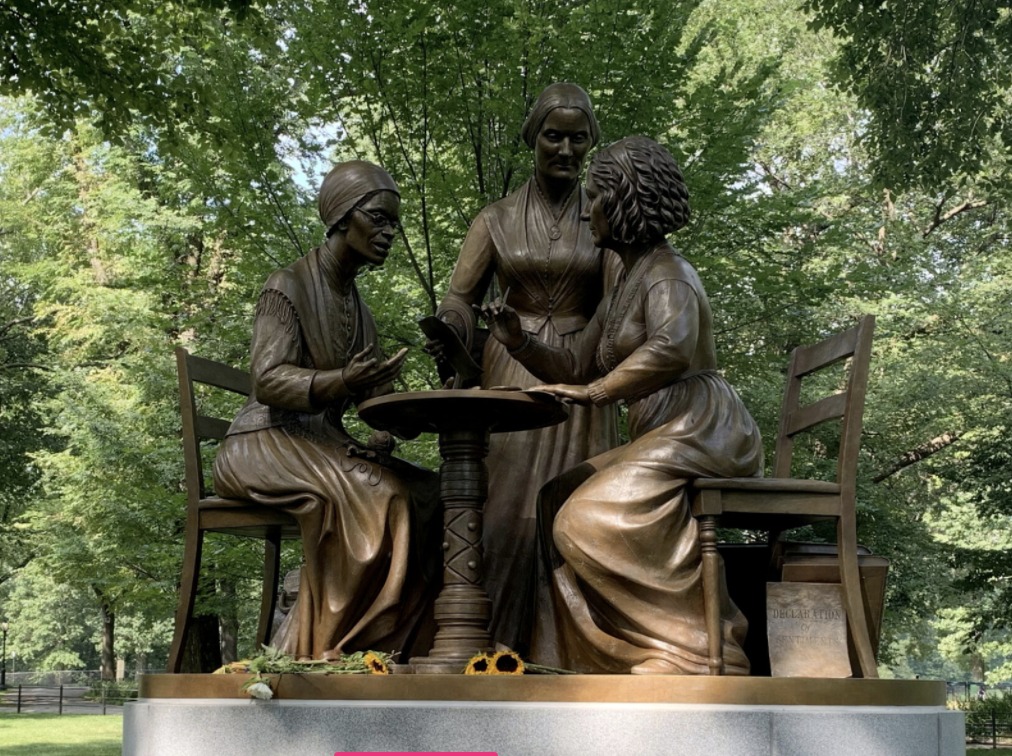
When I was a little girl, my mom took me to storytelling in front of the Hans Christen Anderson statue in Central Park every Sunday.
To get there, enter the park on Center Drive, passing Cuban poet José Julián Martí on horseback. At the Balto the sled-dog, make a left down Literary Walk. Walk down the promenade featuring statues of literary icons like Shakespeare and Robert Burns. Keep walking straight and pass Christopher Columbus. Go down the grand steps until you see a golden angel on top of a fountain.
Make a right, and go under the tunnel. On the other side, you’ll find Alice In Wonderland sitting on a giant mushroom. Pass Alice, go around the conservatory pond. You’ve finally arrived at Anderson, sitting stoically on a slab while reading “The Ugly Duckling.”
Not one of the statues I passed was a real woman. Not one was a person of color. In New York City’s most famous attraction there was a monument dedicated to a dog before anyone who wasn’t a white man. That’s not what my city looks like.
As a kid, I was more interested in climbing the statues than reading their inscriptions. Statues of women are so uncommon to see in New York City that it didn’t cross my mind that there weren’t any. Up until 2020, only five out of NYC’s 150 statues of historic figures depicted real women. That’s 3.3%; women consistently make up over 50% of the population. I saw Alice and the unnamed angel and thought of them as simply art. As an adult, their implications became clearer.
Women do not ride horses, raise fists, write, or read books. Unlike men who are erected and immortalized, women are celebrated for being unreal. Like the angel, we stand atop the pedestal to be gawked at, perfect and virginal. Like Alice, we are fragile and must be protected by a herd of male characters. We look down with a faint smile and reach out to others without speaking up. At least, that’s what the statues told me and the 42 million people that visit Central Park every year.
Central Park’s extensive public art did not feature a woman or person of color until August 2020. The Women’s Rights Pioneers Monument featuring Sojourner Truth, Susan B. Anthony, and Elizabeth Cady Stanton was added to the Literary Walk to commemorate the centennial of the ratification of the 19th Amendment. The women are depicted writing, organizing, and speaking for womens’ right to vote. Never before has a statue of women actively doing something been erected in New York.
I passed that empty patch of grass for 20 years with my mom who raised me by herself. She raised me well enough that I never needed a statue to know I could achieve greatness as a woman. When we first saw the new monument, we both cried. I cried knowing that the young girls who would now pass the statue would internalize that they too can be monumental, just as men.
New York City now has 7 total historic monuments that depict real women. This past Columbus Day, a monument dedicated to Mother Cabrini, the patron saint of immigrants, was unveiled in Battery Park. Cabrini is shown on a paper boat with two orphans. The monument is adorned with panels showing her service to Italian-American immigrants and the poor.
New York is both historically and currently a city of and for immigrants. Immigrants make up nearly a quarter of New York City’s population today and18 percent of the population has at least one foreign-born parent. Immigrants breathe life into this city with a growing population every year. Besides the Statue of Liberty, who is herself an immigrant, there are only two statues in NYC (including Cabrini) depicting immigrants.
What is the point of the pedestal if we don’t celebrate those through history who rightfully deserve recognition and visibility? These statues do not memorialize New Yorkers’ history. They memorialize a white-washed misogynist history that plagues this entire country.
Historical statues have two functions. First, to celebrate a person’s life, a commemoration of someone’s influence that must be remembered. Secondly, to give people role models –figures who inspire others to be monumental. That is not the function of the monument in modern times.
There was a quote I often thought about as a kid. “Until the lions have their own historians, the history of the hunt will always glorify the hunter,” said Chinua Achebe. In America, our history obviously glorifies the hunter. Statues show us our past, but the past we’ve chosen to show is an ugly reminder of where America’s power lies. Who holds physical space determines who has power.
Due to the overwhelming majority of statues depicting white men in the U.S., statues stand as bronzed reminders of oppression, exclusivity, and homogeneity. But the American people are taking it upon themselves to finally change this.
The murder of George Floyd became a catalyst for statues being ripped down this past summer. All over the U.S, monuments to confederate icons like Stonewall Jackson and Jefferson Davis were, protested, vandalized, and removed.
On Juneteenth (the holiday marking the end of slavery), protestors spray painted “Black Lives Matter” and “Fuck White Supremacy” on a statue of Confederate General Albert Pike in Washington D.C. Dozens of protestors gathered to topple the statue, dragging it down with ropes.
Face down on the ground, Pike was set on fire by the protestors as they shouted “let it burn!”
In 2020, old statues coming down are more profound than new ones going up. News sources vigorously reported on confederate statues falling, but most people are unaware that new women’s statues are actively going up in New York. Monuments now function to serve gaps –they fill the holes of celebration that were robbed from most groups in this country up until now.
Instead of solidifying the past, statues now show progress and change. As statues come down, it is as though we are changing history. As new ones go up, we are actively choosing what history to memorialize.



